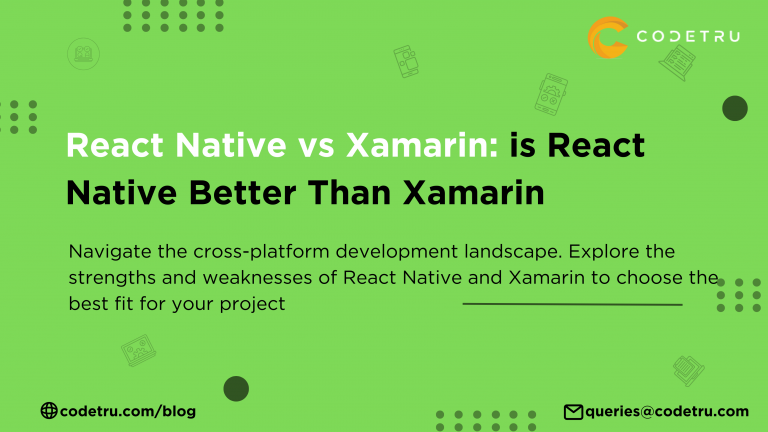
Mobile applications have brought a major shift in the way businesses function, with technologies like React Native and Xamarin leading the charge. With users’ intent to gain information on the go, mobile applications are gaining traction more than ever. The growing trend for developing more mobile apps for each product is also observed.
Despite the small app size on the mobile phone, they come power-packed in performance. So, let’s put the two mobile technologies under the lens and check how they deliver this power-packed performance. We are going to discuss React Native and Xamarin in this blog today, and how they compare with each other.
What is React Native?
React Native is a free and open-source mobile application development framework developed by Facebook in 2015. It leverages JavaScript and React’s capabilities to build cross-platform mobile applications.

The top mobile applications built using React Native are Facebook, Facebook Analytics, Instagram, Uber Eats, Walmart, and Discord, among many others.
Pros and cons of React Native
Advantages of React Native
Native-Like Experience
- React Native uses native UI components, which means your app will have a high-quality, native look and feel. This helps deliver a seamless user experience that closely resembles that of a native application.
Accelerated Development
- With a rich library of pre-built UI components, React Native allows for quicker development and iteration. This can significantly speed up the time-to-market for your application.
Access to Native Features
- React Native provides access to native functionalities such as the camera, GPS, accelerometer, and voice, enabling you to integrate essential features without much hassle.
Hot Reloading
- The hot reload feature allows developers to see changes in real time without needing to recompile the entire app. This can make the development process more efficient and iterative.
Open Source and Well-Supported
- Being free and open-source, React Native benefits from a robust community and strong backing from Facebook. This means frequent updates, a wealth of resources, and community support.
Disadvantages of React Native
Navigation Challenges
- While React Native offers basic navigation capabilities, it falls short when compared to native navigation solutions. This can lead to a less fluid user experience in complex scenarios.
Animation Limitations
- Creating advanced animations in React Native can be challenging. The framework may not offer the same level of performance or flexibility as native solutions, which could impact the smoothness of animations.
What is Xamarin?
Xamarin is a free, open-source mobile application framework that leverages C# in Visual Studio for mobile app development. It can help in building cross-platform apps with a single codebase, however, helps you achieve native app development at the same time. It was developed by Microsoft and introduced in 2011.
As per the official documentation, Xamarin allows for 90% of the time for cross-platform app development.
A few of the most famous applications built using Xamarin include The World Bank, Olo, APX, Fresh Direct, games like Skulls of Shotgun, SuperGiant Games, etc.
Pros and cons of Xamarin
Advantages of Xamarin
- Xamarin is popular for building apps that offer a native look and feel.
- Xamarin. Forms are something that can help with a library of templates with the use of interface elements. The developers can essentially reuse the code across different platforms making the app development process an easier task to handle. Xamarin. Android and Xamarin. iOS helps in building platform-specific native UI components.
- Xamarin comes with an entire suite of products from C# to .Net to Visual Studio for a complete cross-platform mobile application framework experience.
- Xamarin is open source.
Disadvantages of Xamarin
- There are software update delays usually reported with Xamarin. Whenever new features or updates are rolled out, a gap is observed before they are reflected in the Xamarin tools which sometimes results in hindering the app’s performance.
- The Xamarin apps are larger than the native apps. The reason behind this is the fleet of libraries used to convert the C# requests to native requests.
- Building a simple UI works fine with Xamarin, but when it comes to heavy GUI, especially for games might turn out to be a cumbersome process in Xamarin as it results in a lot of platform-specific coding.
React Native Vs Xamarin
Now that we have a fair idea of what React Native and Xamarin are, let’s understand their technical prowess in different areas and see how each performs against the other.
Performance
The one which gives the most native performance is the winner, despite their cross-platform capabilities. Xamarin has an edge over React Native in this aspect as it offers the better native app experience among the two. Furthermore, Xamarin is capable of running the fastest code on both Android and iOS.
Xamarin is the winner.
Popularity
When it comes to the game of popularity, despite Xamarin’s existence for a longer period, React Native has surpassed Xamarin in terms of popularity. One of the main reasons could be that Xamarin is maintained only by Microsoft whereas React Native is open-source.
React Native is the winner.
Programming language
When it comes to programming language for React Native and Xamarin, React Native leverages JavaScript while C# and F# are used in Xamarin. While JavaScript is originally meant for web application development, it is used for mobile app development but with some workarounds. However, the learning curve is simple for JavaScript as compared to C# giving both JavaScript and React Native equal footing where the programming languages are concerned.
It is a draw.
Developer Community
React Native is younger as compared to Xamarin. However, the fact that React Native is JavaScript-based, its popularity, and being open-source are the reasons why the developer community is large for React Native as compared to Xamarin.
React Native is the winner
Development Environment
Both React Native and Xamarin have some special features that enhance performance. React Native has a hot reload feature that updates the app without the need for compilation.
On the other hand, Xamarin. Forms, Xamarin. Android, and Xamarin. iOS help in reusing the code with the help of a library of templates, and help in building native UI components specific to the platform. Xamarin helps with a better native look and feel with its components.
Xamarin is the winner
Compilation speed
JavaScript uses JIT for compilation. And as a rule of thumb compiled languages offer better speed than interpreted languages. It’s because the compiled languages convert the code into machine language. However, C# also used JIT for compilation for Android and not iOS. Further, C# uses an Ahead-of-time (AOT) compiler which is touted to run faster.
Xamarin is the winner.
Cost
Both React Native and Xamarin are open-source for individual use and small companies. However, the Visual Studio Enterprise edition which is required for Xamarin increases the cost to about $3000 per annum.
React Native is cost-effective.
Bottom Line
While both React Native and Xamarin fare equally when we consider different factors, React Native takes the lead in the aspects that matter the most. React Native is a more popular and inexpensive alternative to Xamarin.
FAQs about React Native vs. Xamarin
1. Which is better for cross-platform mobile development, React Native or Xamarin?
Both React Native and Xamarin are good choices for cross-platform mobile development. React Native is extremely popular and cost-effective, using JavaScript for rapid development. Xamarin, backed by Microsoft, offers good native performance and integration with Visual Studio but can be expensive.
2. How does React Native compare to Xamarin in performance?
Xamarin typically delivers better performance and faster code execution for mobile applications due to its native-like capabilities on both Android and iOS. React Native, while performing well, can’t match the performance of Xamarin for resource-intensive applications.
3. What are the costs of using React Native with Xamarin?
React Native is free and open source, making it a cost-effective option, especially for individual developers and small businesses. Xamarin, although also open source, can be costly due to the Visual Studio Enterprise version required for advanced features, which costs around $3000 per year
4. Which has a bigger developer community, React Native or Xamarin?
React Native has a large developer community due to the use of JavaScript, its popularity, and its open-source nature. This extended community offers better support, more libraries, and faster troubleshooting compared to Xamarin.
5. Is it easier to learn React Native than Xamarin?
React Native is often easier for web developers to learn because it uses JavaScript, a language that many developers are already familiar with. Xamarin requires knowledge of C# as well as the .NET framework, for which the learning curve can be easy for those who are not already familiar with these technologies.







